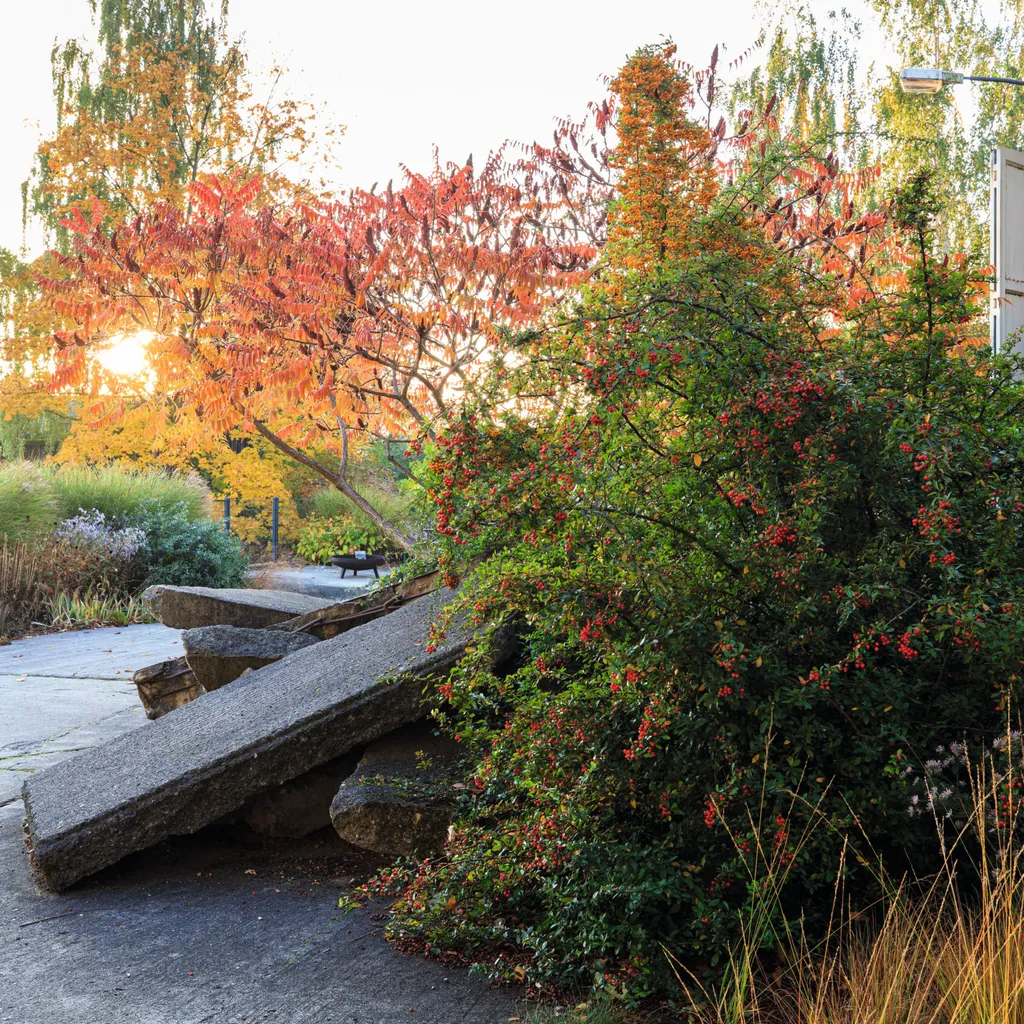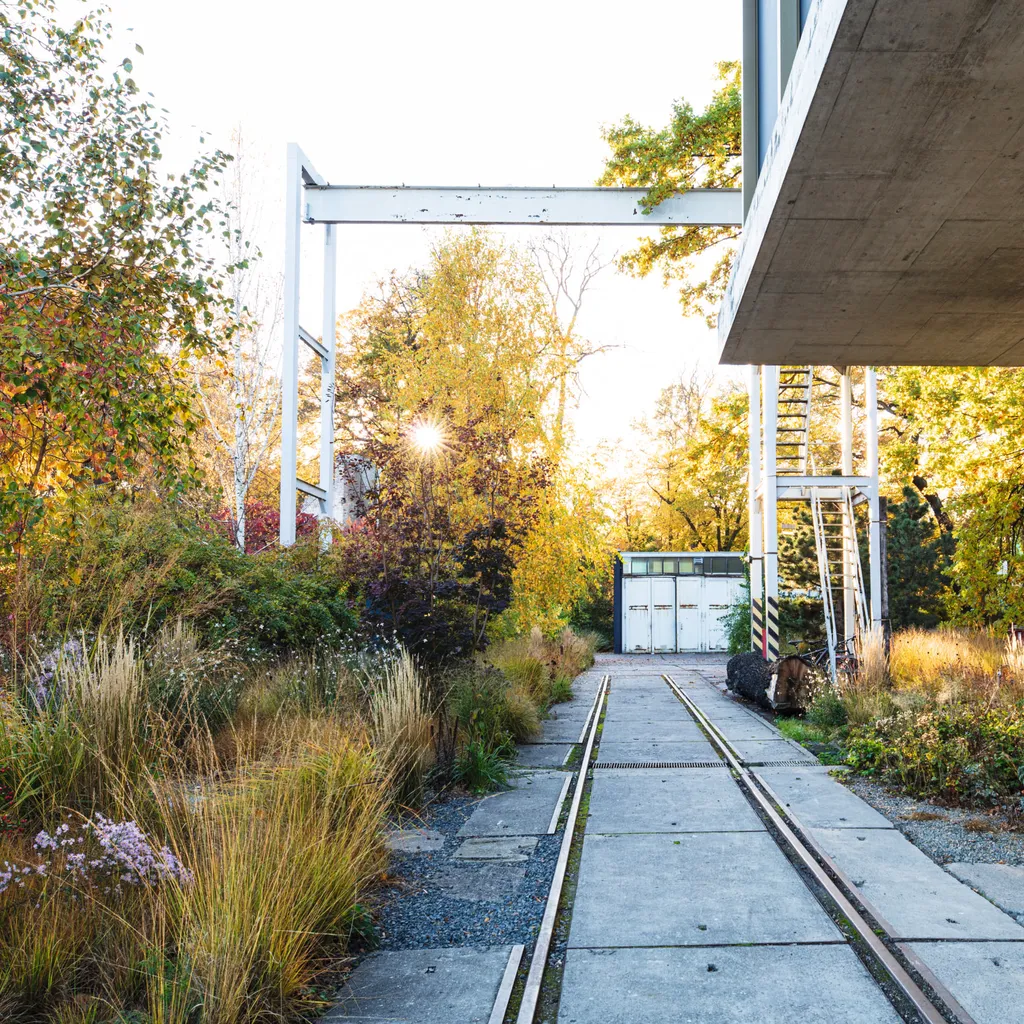Nowadays there are not so many relics of East Berlin’s history – either nature has gradually taken over or new buildings have replaced them,” says Tanja Lincke, the architect behind a ruin garden in southeast Berlin. “For us, it was important to preserve this site’s industrial elements and leave something of the history, even as we gave it a new dimension.”
This refusal to erase the past can be seen in some of the city’s most atmospheric restorations, most memorably perhaps in British architect David Chipperfield’s revival of the heavily bombed Neues Museum. In this garden, however, the ruin was the result not of the Second World War, but the overnight collapse of the German Democratic Republic (GDR). The two-acre site had been the headquarters of the GDR’s city water police, and comprised offices and a vast, dilapidated boat repair shed squatting at its centre. When the Berlin Wall came down in 1989 the vacant buildings were more or less abandoned until they were auctioned off in 2008.

Artist Anselm Reyle put his hand up to buy them. His Kreuzberg studio in central Berlin was becoming cramped and he needed a new creative project. That same year he met Tanja, and soon afterwards the couple embarked on a collaboration to turn this unloved place into a home and shared workplace. Tanja designed the elevated concrete building that appears to float alongside the river Spree and is now their family home, while the original water police buildings have been renovated into the couple’s studios.
“The boat shed at the centre was badly dilapidated. Although we didn’t want to remove it completely, we also didn’t need such a large volume at the centre of the site. That was how the idea for the garden came about,” says Tanja.
She produced a model to envision what it would look like if opened up into a walled garden, and then embarked on fast tracking its decomposition into a ruin. This involved removing the ceiling and parts of the walls with the help of a demolition company, ‘fraying’ the brickwork in a process she calls curated decay.

“Anselm was up on a huge ladder, painting the line of the ruin in purple to show the demolition workers exactly which bricks to remove,” she recalls. The result is an intriguing walled garden that invites you in through its original doorways, but is open to the sky above. The rails that once transported police boats from the river to the shed have been left in place, and an oversized ‘doorway’ frames a view of the Spree, while concrete shards left over from the warehouse floor have been transformed into a riverside sculpture, recreating in three dimensions the painting The Sea of Ice, by the 19th-century German landscape artist Caspar David Friedrich.
With the original structure now open to the elements, the next step was to choose plants. “At first we put in far too many plants,” says Tanje. “Then we visited Piet Oudolf’s High Line garden in New York and realised we wanted to do more with less. So we started over in 2014.”

The couple looked to Berlin garden designer, Harald Jeremias of Das Reservat, for ideas. With his advice they replaced an area of contaminated soil close to the river’s edge, while the soil in the sunnier beds was improved with greywacke sandstone and the shadier beds mulched with compost. They also took the decision to choose plants that would thrive in this region that has a relatively low rainfall and sandy soil. “We wanted to include plants that are the first to take over these abandoned areas,” says Tanja. “So we have birch and sumac trees, and masses of tall grasses.”

In autumn, brilliant colour takes hold, with yellow birch and red sumac leaves, orange rowanberries and feathery golden grasses uniting in a fiery tapestry. In winter, the white-trunked birches, twisting sumac branches and red rosehips cast a moody spell, intensified by the wide grey Spree and bruised skies. Spring brings masses of pale-cream narcissi, followed by the dark-green shades of summer, with tall grasses and pink echinacea flowers thriving in the sheltered warmth. Throughout the year, the precisely cut geometry of the lawn provides a counterpoint to the wild plant life and roughness of the ruin.

Although many of its elements, such as wall tiles, signs, the chimney and the boat hoist, have been left in place, the boathouse does not feel like a frozen museum piece. Constantly activated by the routines of daily life, it’s robust enough for summer barbecues or a game of football, and generous enough to accommodate the family’s caravan in a corner. The walls provide shelter and trap warmth on cooler days, yet the space feels open and light all year round. Reminiscent of English follies, but with an industrial edge, there is a seemingly effortless balance here between the intimidating scale of the original building and the fresh growth within.
USEFUL INFORMATION
The garden opens annually for Gallery Weekend Berlin. See gallery-weekend-berlin.de for details.

In brief
What A garden created around a striking Brutalist-style family home among the ruins of a partly demolished boathouse used by the East German water police. Where Berlin, Germany. Size Two hectares. Soil Sandy soil with some contamination due to its industrial past Climate Warm, humid summers and cold, overcast winters with low rainfall year round. Hardiness zone USDA 8a.
Other ruin gardens
Natur-Park Schöneberger Südgelände This public garden in the east of Berlin was formerly a train marshalling yard. Today, relics, including a 50m water tower, and an old steam train have been incorporated into the design, which has meadows, sculptures, a robinia forest and wild rose. A wheelchair-accessible elevated path running along the old railway tracks makes it easy to enter into this city wilderness.
Lowther On the edge of the Lake District, this 19th-century castle was abandoned in 1936 and demolished in 1957, leaving only the façade and outer walls. In 2008, Dan Pearson began a 20-year project to restore the 130-acre garden. The Garden in the Ruins, in Dan’s signature naturalistic style, is a highlight, alongside a rose garden, wildflower meadows and woodlands.
Nymans Once home to generations of the Messel family, beginning with the garden-loving German stockbroker Ludwig Messel, the Gothic-style property at the heart of this estate in West Sussex was destroyed by a fire in 1947 and the family gifted it to the National Trust in 1953. Recently the garden unveiled its own, highly theatrical, Garden in the Ruins, created as a homage to one of Ludwig’s grandsons, the set designer Oliver Messel.
Scotney Castle This 14th-century moated castle in Kent is home to the National Trust’s only working hop farm. Within the gardens is a medieval castle ruin, which was integrated into the Picturesque design by architect Anthony Salvin and landscape gardener William Sawrey Gilpin between 1834 and 1843.